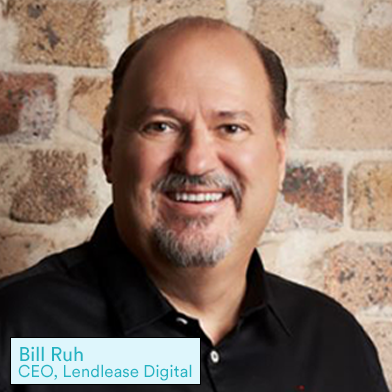
2022 Visions - Digitisation And Designing For Change In The Built World
- by
- Lendlease Podium
The property and construction industry and everything it touches is re-defining new frontiers in living and working. AI, ethical manufacturing, sustainable supply chains and autonomous data driven futures require leadership, creative thinking and vision that goes beyond rudimentary forecasts. In a two-part series, Lendlease Podium speaks with the visionaries of our industry on what they see on the horizon. Our first forecast canvasses the catalysts for transformation in the property and construction industry, the looming issues to solve and how we will remedy them.
In all the lessons that 2021 left to history, a key take-out is that the art of prediction has been rendered almost impossible. Rapid, unpredictable change became the rule rather than the exception and every industry now must integrate a nimble approach and mitigate for chaos. Daunting yes, but transformative also. For the property sector this allows the thinkers, business leaders, creators and builders of our future to rewrite the script, deploy new digital tools and rewrite the outcome. Welcome to 2022.




The Age of Autonomy is Now
The beauty of technology is its lack of neutrality, it disrupts and by definition it creates change. With the age of autonomous building firmly at play supported by deep data insights, creating positive outcomes and solutions will be at a tipping point in 2022. Serious problems including skilled labour shortages, climate change impacts, supply chain issues, access to sustainable materials and implementing sustainable practice can be driven by autonomous strategies.
Lendlease Digital, CEO, Bill Ruh states, “climate regulation will drive adoption of digital across the industry as an essential tool to measure and track carbon emissions. 2022 will be a year of experimentation as we emerge into a post pandemic world.”
He adds that data will be harnessed to determine how people want to use work spaces, public spaces and home requirements. And predicts that “we will also see a return to ‘local’ where regions will embrace local manufacturing and supply as a means to improve efficiency and productivity”.
Schneider Electric, International Operations, Digital Buildings, Real Estate Segment Lead, Antonia Trumbull adds that technology solutions for the real estate sector are not cookie cutter and need creative, technical people who understand the industry to come up with innovative solutions. “They are hard to find but worth their weight in gold. We need to be much more innovative when it comes to digitisation of existing assets. The common approach is to simply replace legacy equipment but a smarter approach utilising system integration, software and analytics can actually reduce this need, significantly reducing capital expenditure and achieving greater outcomes.”
As supply chain issues will continue to cause problems and shortages of materials will probably the most acutely felt, Holmes Solutions, Exec VP – Major Projects, Tim Porter suggest that innovation and autonomous design will ease the way. “Transformation comes from those who are resourceful enough to find innovative ways to solve their problems. Whether it’s doing more with less, or a novel substitution we have been helping many companies create opportunities out of these challenging times. Labour shortages have been causing problems for a long time, and COVID has only exacerbated this with constrained sites suffering. Therefore, we need to get more productivity from fewer people. One way to achieve this is to recast construction jobs so they can be completed with a generalist skillset. The necessary transformation can be achieved through componentized construction with prefabricated elements designed for ease of assembly.”
Climate Change – The Driver for Transforming Business and Outcomes
The entire industry is unified in recognising that the vital existential challenge is climate change and solutions driven by technology and holistic strategy will govern the 2022 response to recovery.
Schneider Electric, Digital Buildings, Strategic Business Development, Michael Wood states that the power of digital will exponentially shift the way we build and operate precincts. “This will truly come to life in 2022. With bold ambitions towards carbon reduction, the only way we will achieve these ambitions is to incorporate digital through the complete lifecycle of development. Right from the onset, by using the digital design tools used to shape a sustainable development, to the digital tools used to manage and operate these precincts.”
As Lendlease continues to implement its commitment to net zero carbon by 2025 and absolute carbon zero in 2040, the race is on. “These commitments are accelerating our adoption of digital as we look to ways in which we can accurately measure carbon emissions across the supply chain in both the construction and operation of physical assets,” explains Ruh.
Predicting the Tech Tools for Disruption
The pandemic created the biggest opportunity for the industry to rewrite the script on digitisation and how technology can shape the future. The push towards accelerated digitalisation in the sector had created the perfect storm for innovation in terms of labour, Porter says “digitization is increasing levels of offsite construction in manufacturing settings. This creates an opportunity to disrupt traditional jobs. By reframing construction as a digitized, computer-oriented occupation there is an opportunity to attract new talent. We have already seen this in the field of manufacturing where a traditional hands-on machinist, is now operating a CNC machine through a computer. It follows that we will see this shift in construction.”
It is clear there is more accelerated change occurring in the building sector now than in the last 50 years combined. With that comes fear of the unknown, technology however is providing a cure for that.
For Ruh the big drivers to look at will be cyber security, as more physical assets become digitally ready, the threat of cyber attacks across a building or place equally increase and will be a leading area of focus for asset and infrastructure owners. He adds that Digital Twins will be the standard for the property industry in 2002. Thirdly, AI and Machine Learning will be significant game changers “with cloud being adopted at a fast pace across the property industry, the ability to harness ML and AI is enhanced.”
Trumbull cautions that technology and data driven decisions need to come from the end users – owners and operators, rather than on a project by project basis. “We are starting to see 12+ months of good quality real time data coming through our integrated platforms. This is activating pattern recognition and AI opportunities which rely on good quality historic data to learn from. “
She adds that the digitisation of buildings is reaching a whole new audience – “From tenants to end user stakeholders (Asset Managers, Heads of Sustainability for example) who are not technical engineers – they need to visualize and access data in a way that is not traditionally done in buildings.”
